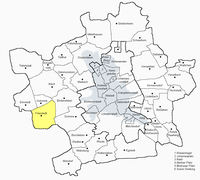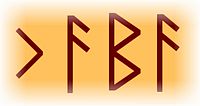Frienstedt ridge

The ridge of Frienstedt dates from the 3rd century and bears a runic inscription , which is the oldest evidence of the West Germanic language . It is the word kaba (pronunciation: "kamba"), a predecessor of our word comb . On the comb made of deer antlers, decorated with circular eye ornaments, the runes are only faintly but clearly recognizable.
Find situation
Archaeologists discovered the triangular ridge in 2000 when investigating the route of the later A 71 near Frienstedt between Erfurt and Gotha in Thuringia . The ridge lay broken together with a lance tip and numerous animal bones in one of several sacrificial shafts that had been set up in an open area in the middle of a Germanic settlement . Richly furnished body graves surrounded this central square in a wide, loose ring, which can therefore be interpreted as a sanctuary. The extraordinary wealth of non-ferrous metal finds (including 200 fibulae , almost 200 Roman coins, a good 150 fragments of Roman ceramics) is evidence that the region held a special position nationwide in the 3rd century AD and, thanks to close contacts with the Roman Empire, also distinguished in the southern Baltic region . When examining the bone and antler objects at the end of 2011, a zoologist discovered the incisions, which are only around 100 to 150 years younger than the oldest known runes from Denmark
interpretation
The linguist and rune expert Klaus Düwel is convinced that the inscription was made in what is now Thuringia. The ending -a in Kaba indicates the West Germanic language form. In Scandinavia the word had a different ending, namely -aR from ancient Germanic * -az . So far, only around 380 rune inscriptions from the 2nd to 7th centuries are known, the vast majority of them come from Scandinavia and are written in Norse or (from around the 7th century) in Old Norse . Only a few dozen legible runic inscriptions from this period have survived from England and the European continent. The oldest from the south-west and north of Germany came - until the discovery of the Frienstedt inscription - from the 5th century.
The evidence of the masculine ending -a at this time is a sensation in terms of linguistic history, as it forms a previously missing link in the development from the original Germanic to the West Germanic language family to which German, Dutch, Frisian and English belong.
exhibition
The find was presented in April 2012 in a small special exhibition in the foyer of the Museum of Prehistory and Early History in Thuringia .
literature
- Christoph G. Schmidt, Robert Nedoma , Klaus Düwel : The runic inscription on the ridge of Frienstedt, city of Erfurt . In: The language . Volume 49, No. 2, 2010–2011, pp. 123–186 (current standard literature on runic inscription)
- Christoph G. Schmidt: Just recycled? A New Light on Roman Imports in Central Germany According to the 'Central Little Farmstead' of Frienstedt, Thuringia . In: Archaeologica Baltica 18, 2013, ISSN 1392-5520 , pp. 86-96. (online) (overview of the Frienstedt site, the author is the head of the corresponding research project at the ZBSA Schleswig)
- Heinrich Tiefenbach , Wolfgang Timpel: Erfurt. In: Reallexikon der Germanischen Altertumskunde (RGA). 2nd Edition. Volume 7, Walter de Gruyter, Berlin / New York 1989, ISBN 3-11-011445-3 , pp. 488-497. (Overview of archeology in Erfurt and the surrounding area)
- Klaus Düwel , Heinrich Tiefenbach , Ingrid Ulbricht: Comb. In: Reallexikon der Germanischen Altertumskunde (RGA). 2nd Edition. Volume 16, Walter de Gruyter, Berlin / New York 2000, ISBN 3-11-016782-4 , pp. 200-207.
Web links
- ZBSA News Archive 2012: Sensational find at the ZBSA: Oldest evidence of the West Germanic language .
- ZBSA project: The central German site in Frienstedt .
- Thüringer Landeszeitung (TLZ): Comb was the first Thuringian word .
Remarks
- ↑ a b c Cf. ZBSA News Archive 2012: Sensational find at the ZBSA: Oldest evidence of the West Germanic language .
- ↑ See Fritz Thyssen Foundation, project concept (BZSA): Role model enemy? The central German site of Frienstedt - Germanic elite under Roman influence . ( Memento of the original from March 22, 2014 in the Internet Archive ) Info: The archive link was inserted automatically and has not yet been checked. Please check the original and archive link according to the instructions and then remove this notice.
- ↑ a b cf. Christoph G. Schmidt: Just recycled? A New Light on Roman Imports in Central Germany According to the 'Central Little Farmstead' of Frienstedt, Thuringia . In: Archaeologica Baltica 18, 2013, ISSN 1392-5520 , pp. 86-96.
- ↑ See Thüringer Landeszeitung (TLZ): Comb was the first Thuringian word . ( Memento of the original from May 3, 2016 in the Internet Archive ) Info: The archive link was automatically inserted and not yet checked. Please check the original and archive link according to the instructions and then remove this notice.
- ↑ See Archeology online: Oldest written discovery in Central Germany ( Memento of the original from August 27, 2013 in the Internet Archive ) Info: The archive link was automatically inserted and not yet checked. Please check the original and archive link according to the instructions and then remove this notice. dated April 13, 2012
